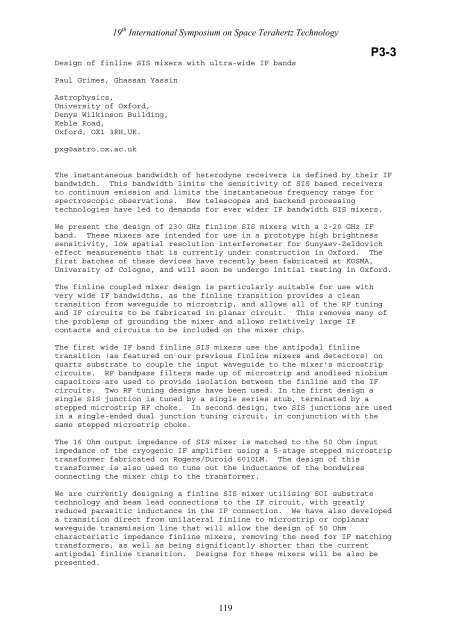Program and Abstract Book - SRON
Program and Abstract Book - SRON
Program and Abstract Book - SRON
You also want an ePaper? Increase the reach of your titles
YUMPU automatically turns print PDFs into web optimized ePapers that Google loves.
19 th International Symposium on Space Terahertz Technology<br />
Design of finline SIS mixers with ultra-wide IF b<strong>and</strong>s<br />
P3-3<br />
Paul Grimes, Ghassan Yassin<br />
Astrophysics,<br />
University of Oxford,<br />
Denys Wilkinson Building,<br />
Keble Road,<br />
Oxford, OX1 3RH,UK.<br />
pxg@astro.ox.ac.uk<br />
The instantaneous b<strong>and</strong>width of heterodyne receivers is defined by their IF<br />
b<strong>and</strong>width. This b<strong>and</strong>width limits the sensitivity of SIS based receivers<br />
to continuum emission <strong>and</strong> limits the instantaneous frequency range for<br />
spectroscopic observations. New telescopes <strong>and</strong> backend processing<br />
technologies have led to dem<strong>and</strong>s for ever wider IF b<strong>and</strong>width SIS mixers.<br />
We present the design of 230 GHz finline SIS mixers with a 2-20 GHz IF<br />
b<strong>and</strong>. These mixers are intended for use in a prototype high brightness<br />
sensitivity, low spatial resolution interferometer for Sunyaev-Zeldovich<br />
effect measurements that is currently under construction in Oxford. The<br />
first batches of these devices have recently been fabricated at KOSMA,<br />
University of Cologne, <strong>and</strong> will soon be undergo initial testing in Oxford.<br />
The finline coupled mixer design is particularly suitable for use with<br />
very wide IF b<strong>and</strong>widths, as the finline transition provides a clean<br />
transition from waveguide to microstrip, <strong>and</strong> allows all of the RF tuning<br />
<strong>and</strong> IF circuits to be fabricated in planar circuit. This removes many of<br />
the problems of grounding the mixer <strong>and</strong> allows relatively large IF<br />
contacts <strong>and</strong> circuits to be included on the mixer chip.<br />
The first wide IF b<strong>and</strong> finline SIS mixers use the antipodal finline<br />
transition (as featured on our previous finline mixers <strong>and</strong> detectors) on<br />
quartz substrate to couple the input waveguide to the mixer's microstrip<br />
circuits. RF b<strong>and</strong>pass filters made up of microstrip <strong>and</strong> anodised niobium<br />
capacitors are used to provide isolation between the finline <strong>and</strong> the IF<br />
circuits. Two RF tuning designs have been used. In the first design a<br />
single SIS junction is tuned by a single series stub, terminated by a<br />
stepped microstrip RF choke. In second design, two SIS junctions are used<br />
in a single-ended dual junction tuning circuit, in conjunction with the<br />
same stepped microstrip choke.<br />
The 16 Ohm output impedance of SIS mixer is matched to the 50 Ohm input<br />
impedance of the cryogenic IF amplifier using a 5-stage stepped microstrip<br />
transformer fabricated on Rogers/Duroid 6010LM. The design of this<br />
transformer is also used to tune out the inductance of the bondwires<br />
connecting the mixer chip to the transformer.<br />
We are currently designing a finline SIS mixer utilising SOI substrate<br />
technology <strong>and</strong> beam lead connections to the IF circuit, with greatly<br />
reduced parasitic inductance in the IF connection. We have also developed<br />
a transition direct from unilateral finline to microstrip or coplanar<br />
waveguide transmission line that will allow the design of 50 Ohm<br />
characteristic impedance finline mixers, removing the need for IF matching<br />
transformers, as well as being significantly shorter than the current<br />
antipodal finline transition. Designs for these mixers will be also be<br />
presented.<br />
119
















